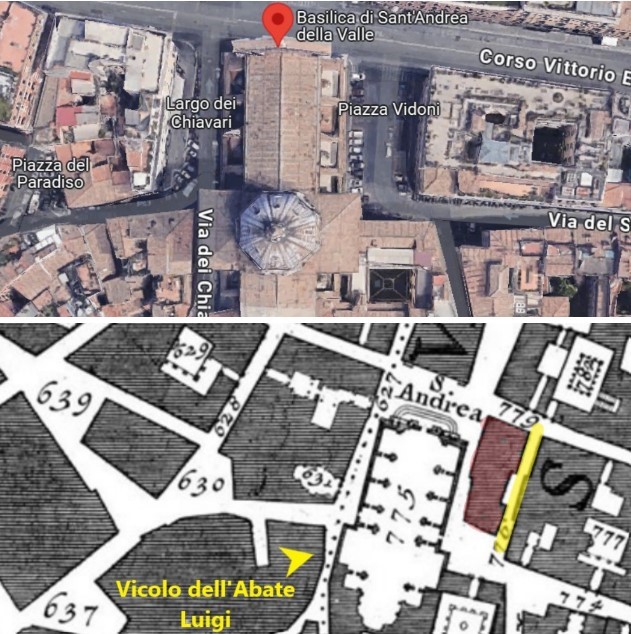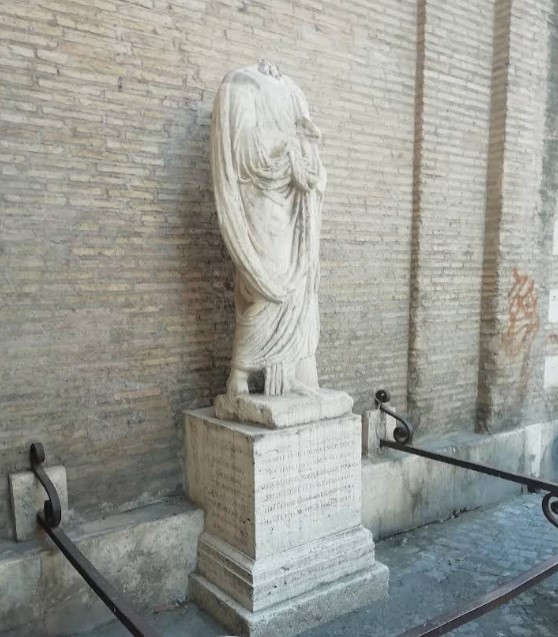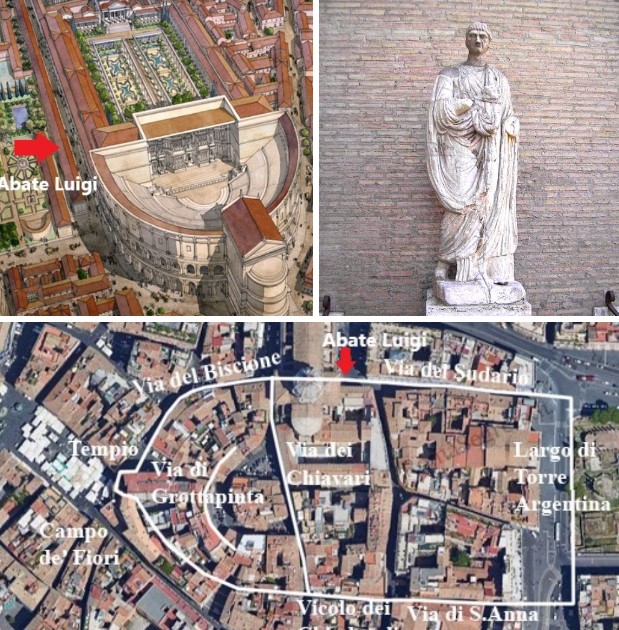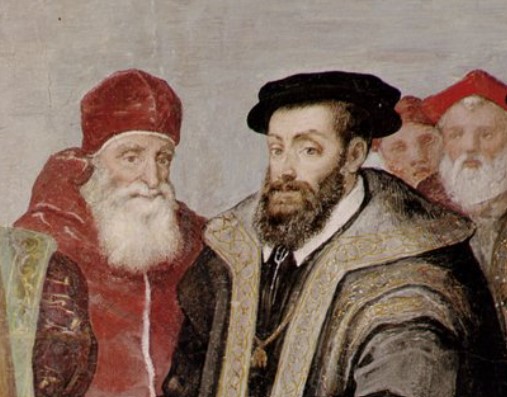Abbot Luigi's Alley and the ancient talking Roman statue in a toga
Rome, Italy
Abbot Luigi Alley was a narrow street in Rome’s Rione VIII, Sant’Eustachio. It served as an extension of Via del Crocifisso (now Monte della Farina) and opened onto Via della Valle, skirting the perimeter of Palazzo Vidoni. In the late 19th century, the block of buildings between Piazza di Sant’Andrea della Valle and the alley was demolished. The cramped, perpetually congested passage—clogged with carriages and hazardous for pedestrians—was dismantled during the urban renovations that created Corso Vittorio Emanuele II and reshaped the adjacent Piazza Sant’Andrea della Valle.

Nolli Map (1748) with Abbot Luigi Alley highlighted (yellow) and the demolished area (red).
The alley owed its name to an ancient late-Roman statue depicting a near life-sized public figure—likely a consul, magistrate, or orator, as suggested by the capsa(a Roman cylindrical case for scrolls) at his feet. The figure wears a tunic draped with a voluminous toga, his right arm bent with a hand resting solemnly on his chest. The original head, severely weathered from prolonged exposure, was repeatedly stolen and replaced over time; today, it is lost entirely.
The common folk dubbed this battered, mutilated sculpture "Abate Luigi" (Abbot Luigi) for its resemblance to the sharp-witted but grotesque sacristan of the nearby Church and Convent of the Holy Shroud of the Savoyards—a man both ridiculed and pitied, mistakenly believed to be an abbot despite his simple role.
The church, a subsidiary of Italy’s Military Ordinariate, traced its origins to 1270, when Piedmontese, Niçard, and Savoyard crusaders returning from the Eighth Crusade formed a small Roman community. In 1597, under Pope Clement VIII, they established the Confraternity of the Holy Shroud to provide charity—shelter, spiritual guidance for the youth, and prison visits. Initially based in the now-vanished San Ludovico Church (later replaced by Sant’Andrea della Valle), the confraternity relocated nearby to Via del Sudario. Under Pope Sixt V (1585–1590), they commissioned their own church, dedicated to the Holy Shroud (Christianity’s most revered relic, now known as the Shroud of Turin), built between 1603 and 1605.
The statue was one of Rome’s six "talking statues"—alongside Pasquino, Marforio, Madama Lucrezia, Facchino, and Babuino—that served as anonymous mouthpieces for public satire. From the Renaissance through the 19th century, Romans clandestinely pinned epigrams or pasquinades (named after Pasquino) to their bases, voicing irreverent critiques of authority without fear of reprisal.

In the narrow Vicolo dell'Abate Luigi (to the left of the Palazzo Vidoni) is a very ancient mutilated statue, called Abate Luigi; the people said it kept up dialogues with Donna Lucrezia, the ancient statue near Saint Marco, similar to those that were supposed to go on between Pasquino and Marforio.
Discovered in the early 1500s during excavations for Palazzo Vidoni—five meters below street level—the statue once stood in the Portico of Pompey’s Theatre, an area later buried by Tiber floods. Known in Latin as Porticus Pompeia(or Ambulatio Magni and Hecatostylon or Hecatostylumthe "Hundred-Columned Portico"), this grand quadriportico behind the theatre’s stage enclosed lush public gardens adorned with art plundered by Gnaeus Pompey Magnus during his campaigns.
Between the 1st century BCE and 1st century CE, Rome boasted covered walkways lining gardens, pools, and fountains, shielding citizens from sun and rain. Pompey’s portico—the first and most famed—was inspired by those he encountered abroad. In 61 BCE, to mark his triumphal anniversary, he erected a theatre, portico, and curia, creating a cultural landmark emulated across the Empire. Inaugurated in 55 BCE with lavish games, Rome’s first all-marble theatre (in the Campus Martius) cleverly circumvented senatorial bans on permanent theatres by incorporating a temple to Venus Victrix—its sacred status legitimizing the structure. The stage entertained 17,000 spectators, while the rear portico doubled as the Curia Pompeia, where Julius Caesar was assassinated on the Ides of March, 44 BCE.
The complex thrived until the 5th century CE, still opulent with marbles and frescoes under Theodoric the Great (454–526 CE). By the Middle Ages, it became a quarry for later buildings.

Location of the Theater of Pompey and the Roman statue called "Abate Luigi"
Palazzo Vidoni, among Rome’s oldest surviving Renaissance palaces, was commissioned in 1515 by the Caffarelli family (designed by Raphael’s pupil Lorenzo Lotto). Acquired by Cardinal Vidoni in the 1700s, it witnessed pivotal events: Pope Paul III Farnese’s 1536 meeting with Emperor Charles V (who lodged here) and the 1925 Pact of Vidoni—a fascist-corporatist deal abolishing free unions and strike rights.

Pope Paul III and Emperor Charles V. Detail from The Truce of Nice by Taddeo Zuccari, 1535-1538, Palazzo Farnese in Caprarola.
The statue endured a nomadic existence: first beside Palazzo Vidoni, then moved indoors to escape vandalism, bearing a witty epitaph by Tomassetti:
I was a citizen of ancient Rome; now all call me Abbot Luigi. With Marforio and Pasquino, I won eternal fame in urban satire. I suffered insults, misfortunes, and burial—yet I was reborn to a secure new life.
Later relocated near Sant’Andrea della Valle, it found no peace. After the alley’s demolition, it was shuffled to Palazzo Chigi’s courtyard (Italy’s government headquarters), then to Palazzo Caffarelli-Vidoni’s staircase niche, and finally—since 1924—to its current spot near the church. Today, the headless sculpture stands as a silent witness to Rome’s layered past.
Rome, Piazza Vidoni, 6
